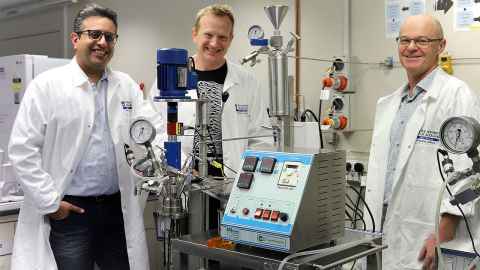Healthcare’s massive carbon footprint
6 August 2019
Opinion: Anaesthetic gas released each year by just one NZ hospital has the same carbon footprint as 500 Auckland and London return flights. Dr Saeid Baroutian explains.

Most people would have no idea that the anaesthetic gases released by just one hospital annually in New Zealand has the carbon footprint of 500 return flights between Auckland and London.
They are probably equally unaware that only 5 percent of these anaesthetic gases are actually used and metabolised by patients in surgery and operating theatres. The other 95 percent simply vents out into the atmosphere.
The aviation industry is known as one of the most polluting industries, but the healthcare sector is as bad: hospitals produce lots of waste, and lots of hazardous waste.
This is what prompted a team of health professionals from Counties Manukau Health (CMH) – anaesthetists and practitioners concerned about the continuing release of these damaging greenhouse gases into the environment – to approach us, the Waste & Biomass Processing Group, in the University of Auckland’s Faculty of Engineering. They were seeking a solution.
Anaesthetic gases are made up of halogenated ethers, toxic chemicals and greenhouse gases. They are hundreds to thousands of times more toxic than carbon dioxide and remain in the atmosphere for a very long time. And of course we all know the effects of greenhouse gases on our atmosphere and on the earth’s climate.
Commonly used anaesthetic gases in New Zealand are Sevoflurane, Desflurane and Isoflurane. All are hydrofluorocarbon and harmful to the ozone layer. They are potent greenhouse gases (up to 3,766 times more potent than CO2). They are currently untreated and vented into the atmosphere.
It seems ironic that life-saving surgeries and medical cures come at such a high cost to the planet...
But there is good news: In collaboration with Dr Rob Burrell and Dr Matt Taylor from the CMH team, we are developing a new adsorptive capture and hydrothermal deconstruction technology for the removal and decomposition of toxic anaesthetic waste. What this means is that first, we capture the anaesthetic gases from hospital operating rooms before they are released into the atmosphere; then we use hot, pressurised water to break down the anaesthetic compounds into safe, inert compounds, mainly water. We are literally busting waste with water.
It is a clean process and is energy efficient. We are confident it is a technology that will help New Zealand’s DHBs meet their environmental responsibilities under the Public Health and Disabilities Act 2000 and within the ethical and quality standards expectations of public sector organisations.
These requirements mean that a DHB would be failing in its duties to knowingly pollute and make no effort to mitigate. Many are already enrolled in a scheme called CEMARS, a Certified Emissions Measurement and Reduction Scheme, and before long, they all will. As part of this scheme, which is run by the state-owned enterprise Enviro-Mark Solutions, DHBs are measuring their CO2 emissions every year, and reducing them, with strategies and goals.
Our technology will enable them to get certified, and report favourably.
The level of awareness amongst anaesthetists of these issues is very high, and anaesthetists are often the largest, or near largest, group of senior doctors in public hospitals. They can be vocal and persuasive.
They also have their own duty of practice with regard to the environment imposed by their professional body, the Australian and New Zealand College of Anaesthetists (ANZCA), which has a commitment to promoting practices that contribute to environmental sustainability.
So far, environmentally-sound options to reduce anaesthetic and medical waste are minimal. Liquid anaesthetics are sometimes used to reduce carbon emissions but this creates a different problem. It is estimated 50 percent of liquid anaesthesia drugs are sent to landfill which leads to environmental pollution and a high risk of water contamination. This is also the case with pharmaceuticals such as antibiotics and steroid-based drugs which enter the waste stream untreated.
In New Zealand, we have relied on disposal methods such as sterilisation, encapsulation where the waste is coated in an inert material to stop leeching into water systems, disposal to landfill and export for incineration off-shore. This latter is despite our commitment to the Basel Convention on the Transboundary Movements of Hazardous Wastes and their Disposal which requires hazardous wastes to be disposed of, wherever possible, in their country of origin.
New Zealand has justified the export of hazardous waste as being the only viable option due to our size and the economics of establishing treatment facilities. But the option of exporting waste is becoming less certain with countries’ increasing restrictions on importation of waste, as we saw with China’s import ban for plastic waste in 2018.
In some countries, high temperature incineration is the only way to get rid of pharmaceutical wastes. But this, while effective, can result in the emission of dioxins, furans, and particulate matter it is not an option in New Zealand due to limitations imposed by the National Environmental Standards for air quality
It seems ironic that life-saving surgeries and medical cures come at such a high cost to the planet, but our district health boards are trying hard to reduce the environmental impacts of hospital waste. The technology we are developing supports these initiatives and could transform dramatically, and safely, the way we dispose of New Zealand’s pharmaceutical and anaesthetic waste.
Dr Saeid Baroutian is from the Faculty of Engineering and leads the Waste & Biomass Processing Group.
This article reflects the opinion of the author and not necessarily the views of the University of Auckland.
Used with permission from Newsroom Healthcare’s massive carbon footprint on 1 August 2019.
Media queries
Alison Sims | Research Communications Editor
DDI 09 923 4953
Mob 021 249 0089
Email alison.sims@auckland.ac.nz